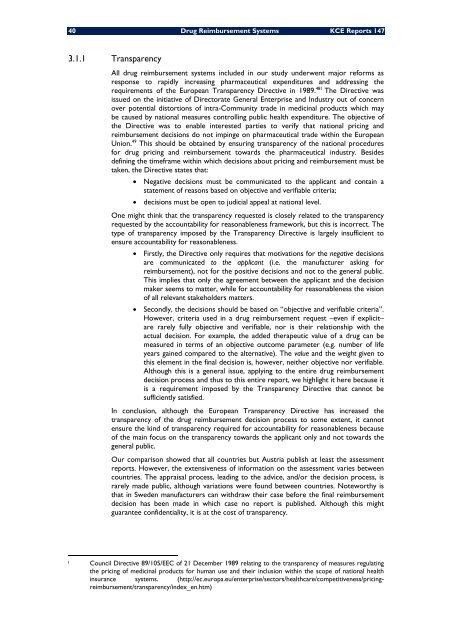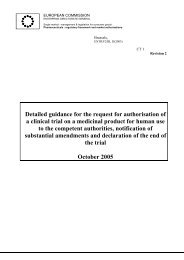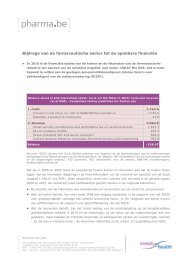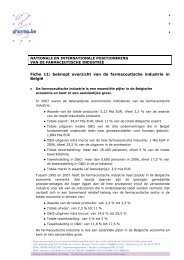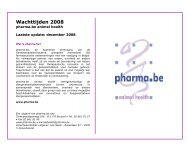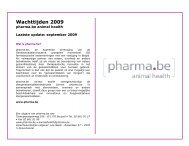Terugbetalingssystemen voor geneesmiddelen ... - Pharma
Terugbetalingssystemen voor geneesmiddelen ... - Pharma
Terugbetalingssystemen voor geneesmiddelen ... - Pharma
- No tags were found...
You also want an ePaper? Increase the reach of your titles
YUMPU automatically turns print PDFs into web optimized ePapers that Google loves.
40 Drug Reimbursement Systems KCE Reports 147<br />
3.1.1 Transparency<br />
All drug reimbursement systems included in our study underwent major reforms as<br />
response to rapidly increasing pharmaceutical expenditures and addressing the<br />
requirements of the European Transparency Directive in 1989. 48l The Directive was<br />
issued on the initiative of Directorate General Enterprise and Industry out of concern<br />
over potential distortions of intra-Community trade in medicinal products which may<br />
be caused by national measures controlling public health expenditure. The objective of<br />
the Directive was to enable interested parties to verify that national pricing and<br />
reimbursement decisions do not impinge on pharmaceutical trade within the European<br />
Union. 49 This should be obtained by ensuring transparency of the national procedures<br />
for drug pricing and reimbursement towards the pharmaceutical industry. Besides<br />
defining the timeframe within which decisions about pricing and reimbursement must be<br />
taken, the Directive states that:<br />
• Negative decisions must be communicated to the applicant and contain a<br />
statement of reasons based on objective and verifiable criteria;<br />
• decisions must be open to judicial appeal at national level.<br />
One might think that the transparency requested is closely related to the transparency<br />
requested by the accountability for reasonableness framework, but this is incorrect. The<br />
type of transparency imposed by the Transparency Directive is largely insufficient to<br />
ensure accountability for reasonableness.<br />
• Firstly, the Directive only requires that motivations for the negative decisions<br />
are communicated to the applicant (i.e. the manufacturer asking for<br />
reimbursement), not for the positive decisions and not to the general public.<br />
This implies that only the agreement between the applicant and the decision<br />
maker seems to matter, while for accountability for reasonableness the vision<br />
of all relevant stakeholders matters.<br />
• Secondly, the decisions should be based on “objective and verifiable criteria”.<br />
However, criteria used in a drug reimbursement request –even if explicit–<br />
are rarely fully objective and verifiable, nor is their relationship with the<br />
actual decision. For example, the added therapeutic value of a drug can be<br />
measured in terms of an objective outcome parameter (e.g. number of life<br />
years gained compared to the alternative). The value and the weight given to<br />
this element in the final decision is, however, neither objective nor verifiable.<br />
Although this is a general issue, applying to the entire drug reimbursement<br />
decision process and thus to this entire report, we highlight it here because it<br />
is a requirement imposed by the Transparency Directive that cannot be<br />
sufficiently satisfied.<br />
In conclusion, although the European Transparency Directive has increased the<br />
transparency of the drug reimbursement decision process to some extent, it cannot<br />
ensure the kind of transparency required for accountability for reasonableness because<br />
of the main focus on the transparency towards the applicant only and not towards the<br />
general public.<br />
Our comparison showed that all countries but Austria publish at least the assessment<br />
reports. However, the extensiveness of information on the assessment varies between<br />
countries. The appraisal process, leading to the advice, and/or the decision process, is<br />
rarely made public, although variations were found between countries. Noteworthy is<br />
that in Sweden manufacturers can withdraw their case before the final reimbursement<br />
decision has been made in which case no report is published. Although this might<br />
guarantee confidentiality, it is at the cost of transparency.<br />
l<br />
Council Directive 89/105/EEC of 21 December 1989 relating to the transparency of measures regulating<br />
the pricing of medicinal products for human use and their inclusion within the scope of national health<br />
insurance systems. (http://ec.europa.eu/enterprise/sectors/healthcare/competitiveness/pricingreimbursement/transparency/index_en.htm)


